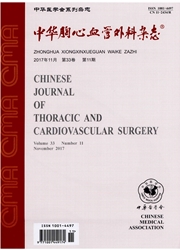

 中文摘要:
中文摘要:
目的 分析肺动脉内膜剥脱术(PEA)治疗慢性栓塞性肺动脉高压的围手术期资料,探讨美国加州大学圣迭戈分校(UCSD)手术经验.方法 回顾性研究UCSD 32例肺动脉血栓内膜剥脱手术资料,其中男17例,女15例;平均年龄(47.56±16.04)岁,平均病程(3.90±4.61)年;15例有深静脉血栓病史.采用全麻、胸骨正中切口、深低温、间断停循环双侧肺动脉内膜剥脱的手术方法.结果 根据术中病理标本Jamieson分型,Ⅰ型占21.8%,Ⅱ型占28.1%,Ⅲ型占37.5%.平均转机(236.32±37.27)min,主动脉阻断(111.69±28.14)min,停循环(38.00±13.58)min.术后机械通气(66.23±99.24)h,住ICU(4.62±4.50)天,无死亡.病人肺动脉收缩压由术前(81.03±16.92)mm Hg(1 mm Hg=0.133 kPa)降至术后(51.20±12.16)mm Hg,肺血管阻力由术前(88.91±42.32)kPa·s·L-1降至术后的(34.38±15.68)kPa·s·L-1,心排量由术前(3.65±1.08)L/min增加到术后(5.85±1.21)L/min,中心静脉压由(13.07±2.11)cmH2O(1 cmH2O=0.098 kPa)降至(9.86±3.02)cmH2O.术后短期随访显示,病人心功能(NYHA)恢复到Ⅰ级19例、Ⅱ级13例,生活质量明显改善.结论 PEA是治疗慢性栓塞性肺动脉高压的重要手段,手术成功率逐年提高;深低温、间断停循环、双侧肺动脉内膜剥脱及内膜外翻技术为PEA标准术式.多中心资料证实该术式可以有效降低肺动脉压和肺血管阻力,明显改善血流动力学指标和心肺功能.多数国内医疗中心没有足够手术经验,应尽量避免选择肺动脉压收缩≥100mmHg,肺血管阻力≥100kPa·s·L^-1及Ⅲ型病变者行PEA手术.
 英文摘要:
英文摘要:
Objective Background Pulmonary endarterectomy (PEA) is a safe and effective surgical treatment for chronic thromboembolic pulmonary hypertension. University of California at San Diego Medical Center is widely recognized as the world's leading referral center for PEA surgery with extensive surgical experience, which has surgically treated about 2400 patients till 2009, which account for more than 50% of the total cases in the world. Methods During visiting in UCSD, 32 pulmonary endarterectomy operations were performed by Prof. Stuart W Jamieson and Mechel M Madani. In these patients, 17 were males (53%), the average age was (47.56 ± 16.04 ) years, 47% with prior history of pulmonary embolism and/or deep vein thrombosis. Obvious pulmonary hypertension and hypoxemia were observed in all patients. Bilateral pulmonary endarterectomy was performed under cardiopulmonary bypass with profound hypothermic circulatory arrest. Results According to the classification of surgical specimens, 21.8% are type Ⅰ , 28.1% are type Ⅱ and 37.5% are type Ⅲ. The average time of cardiopulmonary bypass (CPB) was (236.32 ± 37.27) mins. The aortic cross clamp time was ( 111.69 ± 28.14) mins. The circulatory arrest time was (38.00±13.58 ) mins [ right side (21.39 ± 9.57 ) mins and left side ( 16.61 ± 6.83) mins]. Postoperatively the average mechanical ventilation time was ( 66.23 ± 99.24) hours, and the ICU stay was (4.62 ± 4.50 ) days.There was no postoperative moorality. All cases had significant decrease in systolic pulmonary artery pressure [(81.03 ± 16.92)mm Hg vs. (51.20±12.16) mm Hg] and pulmonary vascular resistance [(88.91 ±42.32) kPa · s · L-1 vs. (34.38 ±15.68 ) kPa · s · L-1 ], great improvement in cardiac output [(3.65 ±1.08 ) L/min vs. ( 5.85 ± 1.21 ) L/min ] and central venous pressure [(13.07 ± 2.11) cmH2O vs. ( 9.86 ± 3.02 ) cmH2O] postoperatively compared to preoperative data. Shortterm follow-up showed that the cardiac fu
 同期刊论文项目
同期刊论文项目
 同项目期刊论文
同项目期刊论文
 期刊信息
期刊信息
